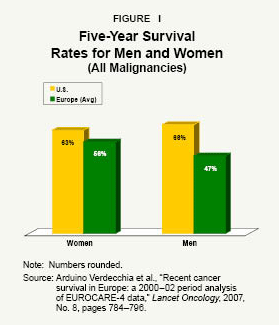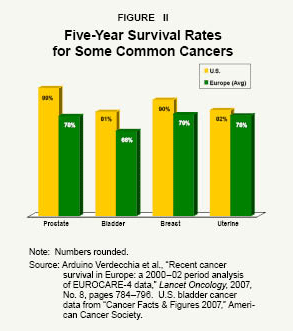During this presidential election season, candidates are urging Americans to radically overhaul our “broken” health care system. Before accepting the premise that the system is broken, consider the impressive evidence from the largest ever international study of cancer survival rates. The data show that cancer patients live longer in the United States than anywhere else on the globe.
Overall Cancer Survival Rates. According to the survey of cancer survival rates in Europe and the United States, published recently in Lancet Oncology : 1
- American women have a 63 percent chance of living at least five years after a cancer diagnosis, compared to 56 percent for European women. [See Figure I.]

- American men have a five-year survival rate of 66 percent — compared to only 47 percent for European men.
- Among European countries, only Sweden has an overall survival rate for men of more than 60 percent.
- For women, only three European countries (Sweden, Belgium and Switzerland) have an overall survival rate of more than 60 percent.
These figures reflect the care available to all Americans, not just those with private health coverage. Great Britain, known for its 50-year-old government-run, universal health care system, fares worse than the European average: British men have a five-year survival rate of only 45 percent; women, only 53 percent.
Survival Rates for Specific Cancers. U.S. survival rates are higher than the average in Europe for 13 of 16 types of cancer reported in Lancet Oncology , confirming the results of previous studies. As Figure II shows:
- Of cancers that affect primarily men, the survival rate among Americans for bladder cancer is 15 percentage points higher than the European average; for prostate cancer, it is 28 percentage points higher. 2
- Of cancers that affect women only, the survival rate among Americans for uterine cancer is about 5 percentage points higher than the European average; for breast cancer, it is 14 percentage points higher.
- The United States has survival rates of 90 percent or higher for five cancers (skin melanoma, breast, prostate, thyroid and testicular), but there is only one cancer for which the European survival rate reaches 90 percent (testicular).
Furthermore, the Lancet Oncology study found that lung cancer patients in the United States have the best chance of surviving five years — about 16 percent — whereas patients in Great Britain have only an 8 percent chance, which is lower than the European average of 11 percent.

Results for Canada. Canada's system of national health insurance is often cited as a model for the United States. But an analysis of 2001 to 2003 data by June O'Neill, former director of the Congressional Budget Office, and economist David O'Neill, found that overall cancer survival rates are higher in the United States than in Canada: 3
- For women, the average survival rate for all cancers is 61 percent in the United States, compared to 58 percent in Canada.
- For men, the average survival rate for all cancers is 57 percent in the United States, compared to 53 percent in Canada.
Early Diagnosis. It is often claimed that people have better access to preventive screenings in universal health care systems. But despite the large number of uninsured, cancer patients in the United States are most likely to be screened regularly, and once diagnosed, have the fastest access to treatment. For example, a Commonwealth Fund report showed that women in the United States were more likely to get a PAP test for cervical cancer every two years than women in Australia, Canada, New Zealand and Great Britain, where health insurance is guaranteed by the government. 4
- In the United States, 85 percent of women aged 25 to 64 years have regular PAP smears, compared with 58 percent in Great Britain.
- The same is true for mammograms; in the United States, 84 percent of women aged 50 to 64 years get them regularly — a higher percentage than in Australia, Canada or New Zealand, and far higher than the 63 percent of British women.
Access to Treatments and Drugs. Early diagnosis is important, but survival also depends on getting effective treatment quickly. However, long waits for treatment are “common devices used to restrict access to care in countries with universal health insurance,” according to a report in Health Affairs . 5 The British National Health Service has set a target for reducing waits to no more than 18 weeks between the time their general practitioner refers them to a specialist and they actually begin treatment. A study by the Royal College of Radiologists showed that such long waits are typical, and 13 percent of patients who need radiation never get it due to shortages of equipment and staff. 6
Another reason for the higher cancer survival rates in the United States is that Americans can get new, effective drugs long before they are available in most other countries. A report in the Annals of Oncology by two Swedish scientists found: 7
- Cancer patients have the most access to 67 new drugs in France, the United States, Switzerland and Austria.
- Erlotinib, a new lung cancer therapy, was 10 times more likely to be prescribed for a patient in the United States than in Europe.
One of the report's authors, Nils Wilking, from the Karolinska Institute in Stockholm, explained that nearly half the improvement in survival rates in the United States in the 1990s was due to “the introduction of new oncology drugs,” and he urged other countries to make new drugs available faster.
Conclusion. International comparisons establish that the most important factors in cancer survival are early diagnosis, time to treatment and access to the most effective drugs. Some uninsured cancer patients in the United States encounter problems with timely treatment and access, but a far larger proportion of cancer patients in Europe face these troubles. No country on the globe does as good a job overall as the United States. Thus, the U.S. government should focus on ensuring that all cancer patients receive timely care, rather than radically overhauling the current system.
- Arduino Verdecchia et al., "Recent cancer survival in Europe : a 2000–02 period analysis of EUROCARE-4 data," Lancet Oncology, 2007, No. 8, pages 784–796.
- The U.S. bladder cancer data is from "Cancer Facts & Figures 2007," American Cancer Society. Available at http://www.cancer.org/downloads/STT/CAFF2007PWSecured.pdf.
- June O'Neill and Dave M. O'Neill, "Health Status, Health Care and Inequality: Canada vs. the U.S.," National Bureau of Economic Research, NBER Working Paper 13429, September 2007. Available at http://www.nber.org/papers/w13429.
- K. Davis et al., "Mirror, Mirror on the Wall: An International Update on the Comparative Performance of American Health Care," Commonwealth Fund, May 2007. Available at http://www.commonwealthfund.org/publications/publications_show.htm?doc_id=482678.
- Sharon Willcox et al., "Measuring And Reducing Waiting Times: A Cross-National Comparison Of Strategies,"
Health Affairs , Vol. 26, No. 4, July/August 2007, pages 1,078-1,087. - M.V. Williams et al., "Radiotherapy Dose Fractionation, Access and Waiting Times in the Countries of the UK in 2005," Royal College of Radiologists, Clinical Oncology , Volume 19, Issue 5, June 2007, pages 273-286.
- Bengt Jönsson and Nils Wilking, "A Global Comparison Regarding Patient Access to Cancer Drugs," Annals of Oncology , Vol. 18, Supplement 3, June 2007.
Betsy McCaughey, a former lieutenant governor of New York, is chairman of the Committee to Reduce Infection Deaths ( http://www.hospitalinfection.org/) .